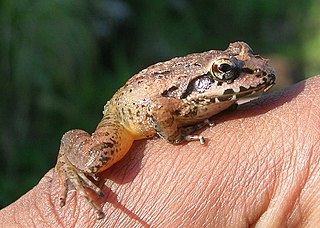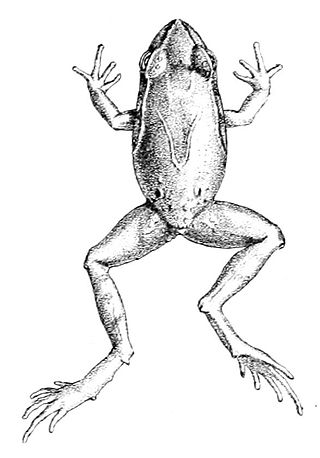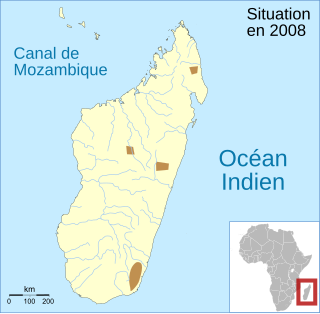
The harlequin poison frog, also known as harlequin poison-dart frog, is a species of poison dart frog endemic to the Chocó region of western Colombia. The frog is normally found on the ground of tropical rain forests, among fallen limbs or leaf litter. Some frogs traditionally classified as Oophaga histrionica were separated as new species in 2018. These are Oophaga anchicayensis, Oophaga andresi and Oophaga solanensis.

Indirana semipalmata is a species of frog endemic to the Western Ghats region of southern India. They are small frogs, reaching lengths of about 36 mm (1.4 in) from snout to vent. The species breeds during the monsoons, laying their eggs on moist rocks and tree bark. Their tadpoles are terrestrial – hatching, feeding, and undergoing metamorphosis without ever entering any standing bodies of water.

Andinobates altobueyensis is a species of frog in the family Dendrobatidae. It is endemic to Alto del Buey mountain in the Serranía del Baudó range, in the Chocó Department of western Colombia. Its common names include Alto de Buey poison frog, golden poison-arrow frog, and golden poison frog.
The polkadot poison frog is a species of frogs in the family Dendrobatidae endemic to Panama, where it is known as rana venenosa in Spanish. Its natural habitats are humid lowland and montane forests. It is threatened by habitat loss and is listed by the IUCN as being "critically endangered".

The granular poison frog or granular poison arrow frog is a species of frog in the family Dendrobatidae, found in Costa Rica and Panama. Originally described as Dendrobates granuliferus, it was moved to Oophaga in 1994. Its natural habitats are tropical humid lowland forests; it is threatened by habitat loss.

Lehmann's poison frog or the red-banded poison frog is a species of frogs in the family Dendrobatidae endemic to a small part of western Colombia. Its natural habitats are submontane tropical rainforests. It is threatened by habitat loss and collection for the pet trade, and the IUCN lists it as being "critically endangered". It was named after Colombian conservation biologist Federico Carlos Lehmann.

The blue-bellied poison frog or bluebelly poison frog is a species of frog in the family Dendrobatidae.
The La Brea poison frog is a species of frogs in the family Dendrobatidae endemic to the Cordillera Occidental in the Cauca Department of Colombia.

Ranitomeya vanzolinii, also known as the Brazilian poison frog or spotted poison frog, is a species of frog from the family Dendrobatidae. It is found in the Amazonian rainforests of Brazil and Peru, and possibly Bolivia.
The bromeliad tree frog is a species of frogs in the family Hylidae.

The Chamula mountain brook frog is a species of frog in the family Hylidae endemic to Chiapas, Mexico. Its natural habitats are moist montane forests. It is threatened by habitat destruction and has been rated as "endangered" by the IUCN.
Myersiohyla inparquesi is a species of frog in the family Hylidae. It appears to be endemic to the summit of Cerro Marahuaca, a tepui in central Amazonas state, Venezuela. Its natural habitats are tepui shrub and forests. Tadpoles live in fast-flowing streams.

Phytotriades is a genus of tree frogs in the family Hylidae. As currently delimited, the genus is monotypic and contains Phytotriades auratus, commonly known as the golden tree frog, bromeliad-dwelling treefrog, El Tucuche golden tree frog, or Trinidad heart-tongued frog.
Leptopelis nordequatorialis, also known as the West Cameroon forest treefrog, is a species of frog in the family Arthroleptidae. It is found in central and western Cameroon and eastern Nigeria. It is closely related to Leptopelis anchietae and Leptopelis oryi.

Adelophryne maranguapensis is a species of frog in the family Eleutherodactylidae. It is endemic to Serra de Maranguape, just west of Fortaleza, in Ceará state, northeastern Brazil.

Eupsophus calcaratus is a species of frog in the family Alsodidae. It is endemic to Patagonia. It has one of the broadest distributions of any Chilean frog.

Stefania breweri, also known as Brewer's carrying frog, is a species of frog in the family Hemiphractidae. It is endemic to Cerro Autana, Venezuela, and only known from a single specimen (holotype). It was named for Venezuelan explorer Charles Brewer-Carías.

Guibemantis albolineatus, also known as the white-lined Madagascar frog, is a species of frog in the family Mantellidae. It is endemic to Madagascar. It is known from the southeastern part of the island. However, there is some confusion between this species and Guibemantis bicalcaratus, as well as possibly undescribed species, making its actual distribution unclear.
Otophryne steyermarki is a species of frog in the family Microhylidae. It is found in western Guyana and in the Bolívar state in eastern Venezuela.
Ceuthomantis aracamuni, also known as the Cerro Aracamuni emerald-barred frog, is a species of frog in the family Ceuthomantidae. It is endemic to Cerro Aracamuni in southern Amazonas, Venezuela.













